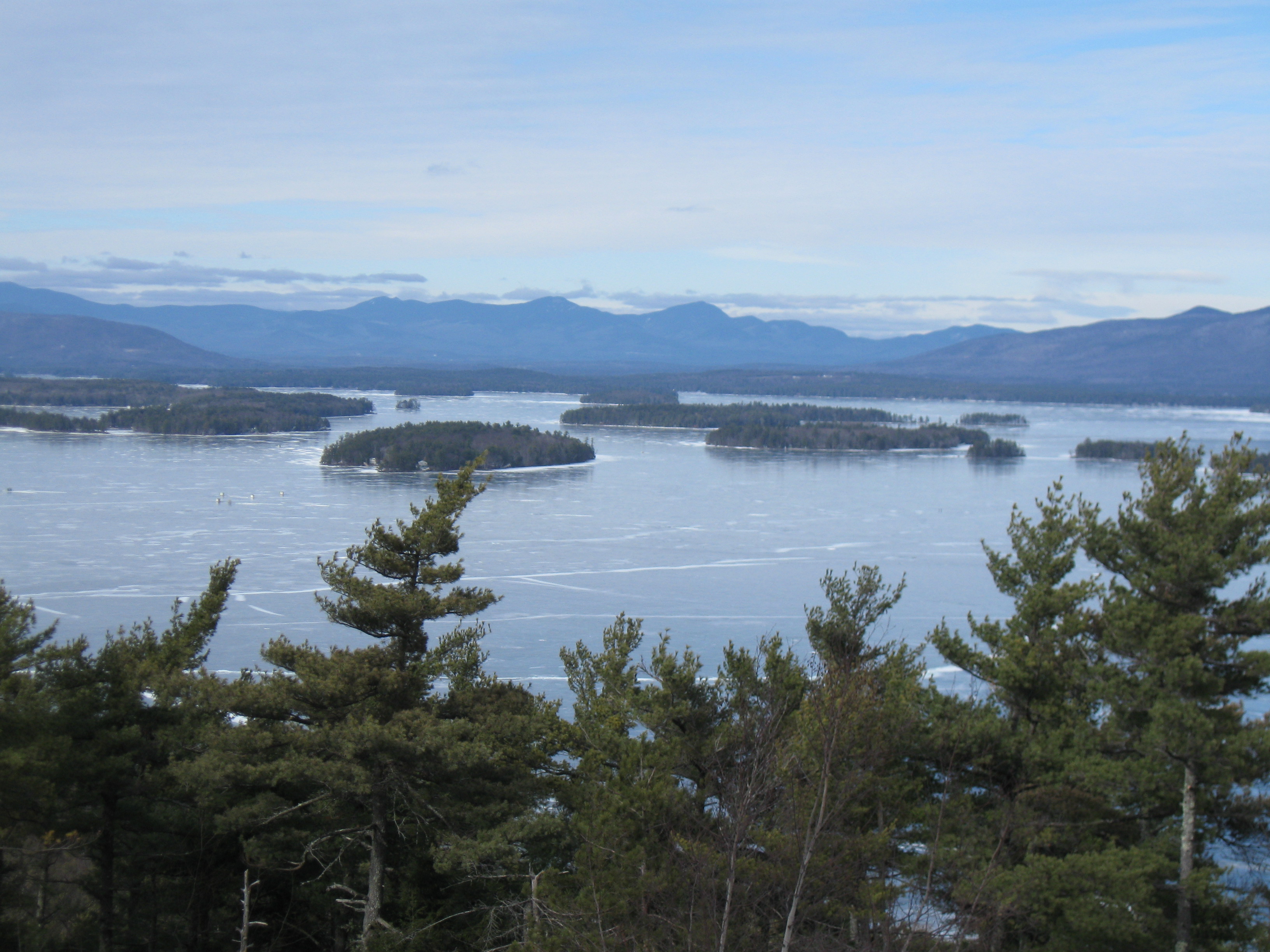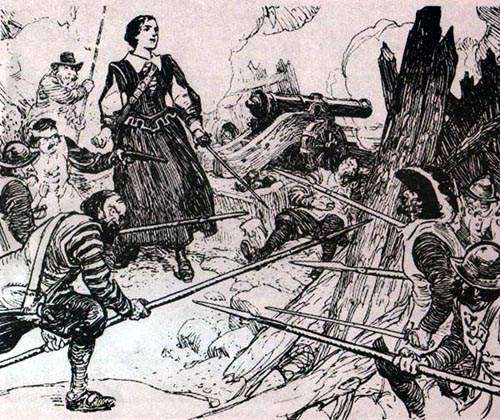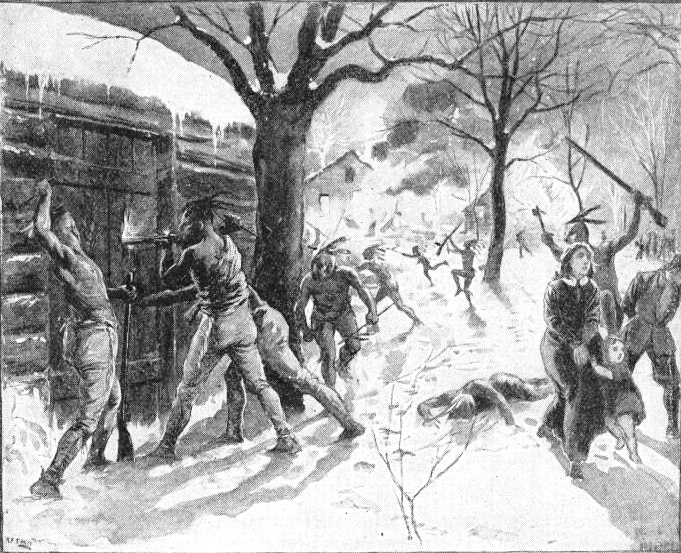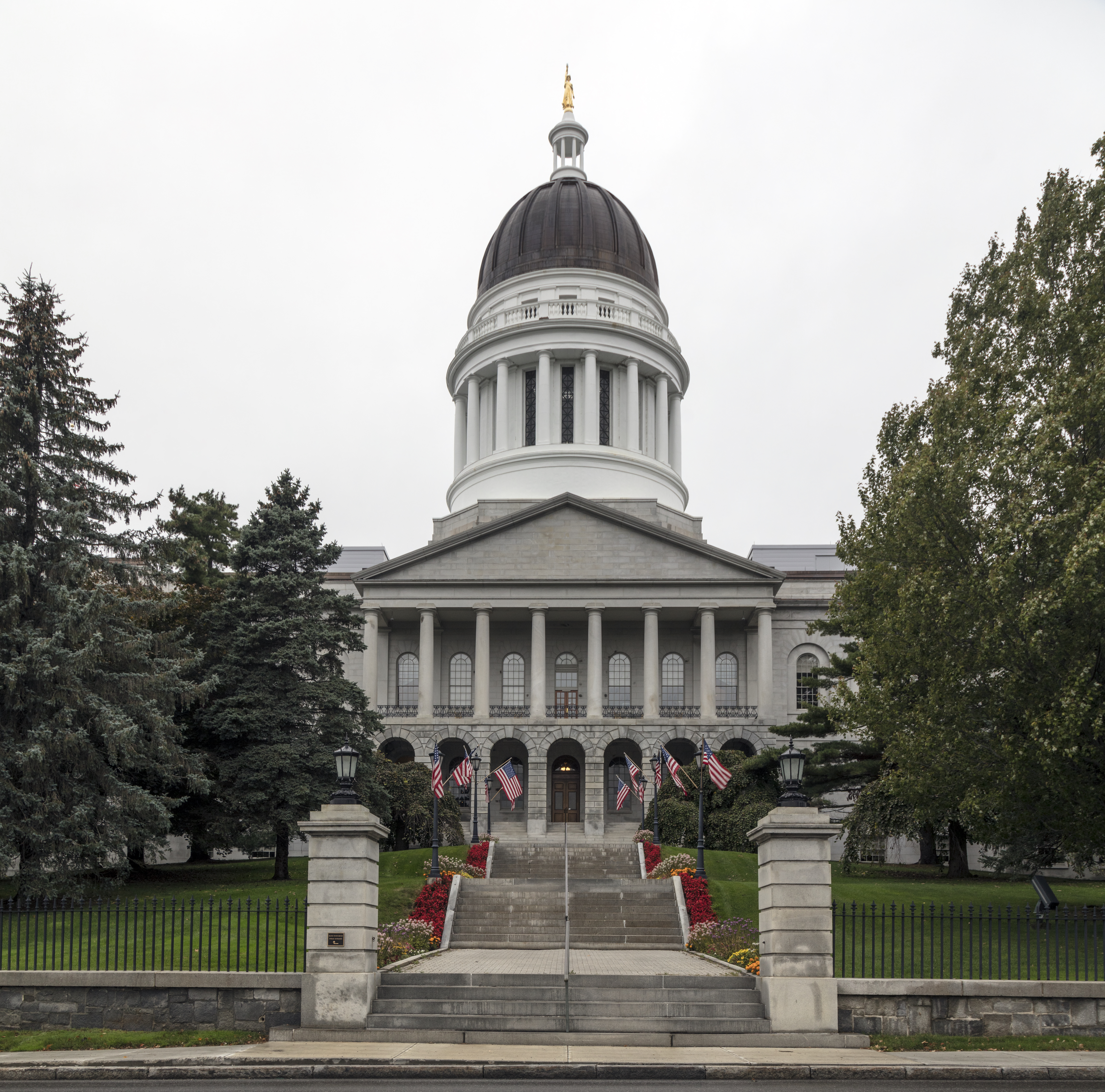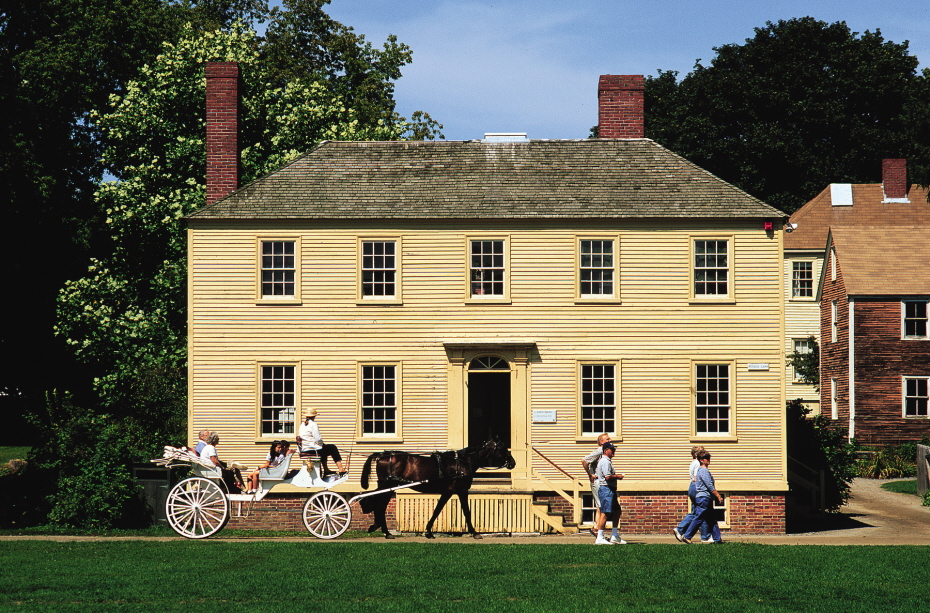|
Raid On Haverhill (1708)
The Raid on Haverhill was a military engagement that took place on August 29, 1708, during Queen Anne's War. French, Algonquin, and Abenaki warriors under the command of Jean-Baptiste Hertel de Rouville descended on Haverhill, then a small frontier community in the Province of Massachusetts Bay. In the surprise attack, 16 people were killed and another 14 to 24 were taken captive. A rapid militia muster gave chase, and in a skirmish later in the day, nine of the French and Indian party were killed and some of their prisoners escaped. Haverhill was not the original target of the raiders. Expecting a larger Indian contingent, French authorities planned to engage in a series of raids on the communities of the Piscataqua River. However, the unwillingness of some Indian tribes to participate in the expedition forced the French to reduce the scope of the operation and choose an easier target. The raid was more costly to the French than previous frontier raids like that in 1704 ... [...More Info...] [...Related Items...] OR: [Wikipedia] [Google] [Baidu] |
Jean-Baptiste Hertel De Rouville
Jean-Baptiste Hertel de Rouville (26 October 1668 – 30 June 1722) was a colonial military officer of New France in the French Marines in Canada. He is best known in North America for leading the raid on Deerfield, in western Province of Massachusetts Bay, against English settlers on 29 February 1704 during Queen Anne's War. Retrieved 13 November 2022. A dedicated soldier, he was widely reviled by the settlers of New England for his tactics of raiding poorly defended frontier settlements. During the years of this war, he also participated in military operations against the English in Newfoundland. He played a role in the early settlement of Île-Royale (present-day Cape Breton Island), after that war. King William's War Hertel de Rouville was born in 1668 into a military family in Trois-Rivières, in the colony of Canada, New France. He was the third son of Joseph-François Hertel de la Fresnière (1642—1722), also born in Trois-Rivières, and his wife. Active in the ... [...More Info...] [...Related Items...] OR: [Wikipedia] [Google] [Baidu] |
Acadia
Acadia (; ) was a colony of New France in northeastern North America which included parts of what are now the The Maritimes, Maritime provinces, the Gaspé Peninsula and Maine to the Kennebec River. The population of Acadia included the various indigenous First Nations in Canada, First Nations that comprised the Wabanaki Confederacy, the Acadian people and other French people, French settlers. The first capital of Acadia was established in 1605 as Port-Royal (Acadia), Port-Royal. Soon after, English forces of Captain Argall, an English ship's captain employed by the Virginia Company of London attacked and burned down the Port-Royal National Historic Site, fortified habitation in 1613. A new centre for Port-Royal was established nearby, and it remained the longest-serving capital of French Acadia until the British Siege of Port Royal (1710), siege of Port Royal in 1710. There were six colonial wars in a 74-year period in which British interests tried to capture Acadia, starting ... [...More Info...] [...Related Items...] OR: [Wikipedia] [Google] [Baidu] |
Lake Winnipesaukee
Lake Winnipesaukee () is the largest lake in the U.S. state of New Hampshire, located in the Lakes Region at the foothills of the White Mountains. It is approximately long (northwest-southeast) and from wide (northeast-southwest), covering — when Paugus Bay is included—with a maximum depth of . The center area of the lake is called The Broads. The lake contains at least 264 islands, half of which are less than in size, and is indented by several peninsulas, yielding a total shoreline of approximately . The driving distance around the lake is . It is above sea level. Winnipesaukee is the third-largest lake in New England after Lake Champlain and Moosehead Lake. Outflow is regulated by the Lakeport Dam in Lakeport, New Hampshire, on the Winnipesaukee River. History The Abenaki name ''Winnipesaukee'' (often spelled Winnipiseogee in earlier centuries) means either "smile of the Great Spirit" or "beautiful water in a high place". At the outlet of the lake ... [...More Info...] [...Related Items...] OR: [Wikipedia] [Google] [Baidu] |
Province Of New York
The Province of New York was a British proprietary colony and later a royal colony on the northeast coast of North America from 1664 to 1783. It extended from Long Island on the Atlantic, up the Hudson River and Mohawk River valleys to the Great Lakes and North to the colonies of New France and claimed lands further west. In 1664, Charles II of England and his brother James, Duke of York raised a fleet to take the Dutch colony of New Netherland, then under the Directorship of Peter Stuyvesant. Stuyvesant surrendered to the English fleet without recognition from the Dutch West India Company. The province was renamed for the Duke of York, as its proprietor. England's rule was established ''de facto'' following military control in 1664, and became established ''de jure'' as sovereign rule in 1667 in the Treaty of Breda and the Treaty of Westminster (1674). It was not until 1674 that English common law was applied in the colony. In the late 18th century, colonist ... [...More Info...] [...Related Items...] OR: [Wikipedia] [Google] [Baidu] |
Jérôme Phélypeaux
Jérôme Phélypeaux, Count of Pontchartrain (March 1674 – 8 February 1747), ''comte de'' (count of) Pontchartrain, was a French statesman, son of Louis Phélypeaux and Marie de Maupeou. Biography He served as a councillor to the parlement of Paris from 1692, and served as Secretary of State of the Maison du Roi and Navy Minister from 1699 onwards. His management of the French Navy was criticised, but recent historiography has reevaluated his contributions. He directed a significant programme of explorations and encouraged the settlement and development of Louisiana. He was responsible for the creation of the Académie des Inscriptions et Belles-Lettres. Private life His first marriage, in 1697, was with Éléonore Christine de La Rochefoucauld de Roye (1681-1708) (known as ''Mademoiselle de Chefboutonne'') (1681–June 1708). Five children were born to this marriage: #Marie Françoise Christine (1698–1701) #Louis François (1700–1708), comte de Maurepas ... [...More Info...] [...Related Items...] OR: [Wikipedia] [Google] [Baidu] |
Port-Royal (Acadia)
Port Royal (1605–1713) was a historic settlement based around the upper Annapolis Basin in Nova Scotia, Canada, and the predecessor of the modern town of Annapolis Royal. It was the first successful attempt by Europeans to establish a permanent settlement in what is today known as Canada. Port Royal was a key step in the development of New France and was the first permanent base of operations of the explorer Samuel de Champlain, who would later found Quebec City, Quebec in 1608, and the farmer Louis Hébert, who would resettle at Quebec in 1617. For most of its existence, it was the capital of the New France colony of Acadia. Over 108 years control would pass between France, Scotland, England and Great Britain until it was formally ceded to Great Britain in 1713 due to the Treaty of Utrecht. From 1605 to 1613 the settlement was centred around the habitation on the north side of the Annapolis Basin, while from 1629 onwards it was centred around Fort Anne on the south side, ... [...More Info...] [...Related Items...] OR: [Wikipedia] [Google] [Baidu] |
Siege Of Port Royal (1707)
The siege of Port Royal consisted of two separate attempts in 1707 by the British New England Colonies to conquer the French colony of Acadia by capturing its capital of Port-Royal during Queen Anne's War. Both attempts were made by colonial troops and were led by officers inexperienced in siege warfare. Led by governor of Acadia Daniel d'Auger de Subercase, the French garrison at Port-Royal easily withstood both attempts, assisted by Acadian militia and the Wabanaki Confederacy outside the fort. The first siege began on June 6, 1707, and lasted 11 days. Provincial troops led by Colonel John March were able to establish positions near Port-Royal's fort, but March's engineer claimed the necessary cannons could not be landed, and the British force withdrew amid disagreements in their war council. The second siege began August 22, and was never able to establish secure camps, owing to spirited defensive sorties organized by Subercase. Both siege attempts were viewed as a debac ... [...More Info...] [...Related Items...] OR: [Wikipedia] [Google] [Baidu] |
Philippe De Rigaud Vaudreuil
Philippe de Rigaud, Marquis de Vaudreuil (; c. 1643 – 10 October 1725) was a French military officer who served as Governor General of New France (now Canada and U.S. states of the Mississippi Valley) from 1703 to 1725, throughout Queen Anne's War and Father Rale's War. Life and career He was born at the Castle of Vaudreuil near Castelnaudary in France. He was the second son of Jean-Louis de Rigaud (d. 1659), Baron de Vaudreuil, Seigneur d' Auriac and de Cabanial, by his wife Marie de Château-Verdun. She was the daughter of François, Seigneur de la Razairie. As Chevalier de Vaudreuil, he was sent to command French forces in New France before being appointed Governor of Montreal in 1699, and then Governor General of New France in 1703. He died at Quebec City. He married Louise Élisabeth de Joybert, a daughter of Pierre de Joybert de Soulanges et de Marson, by his wife Marie-Françoise, daughter of Louis-Théandre Chartier de Lotbinière. They lived at Château Vaudreuil, ... [...More Info...] [...Related Items...] OR: [Wikipedia] [Google] [Baidu] |
Raid On Grand Pré
The Raid on Grand Pré was the major action of a raiding expedition conducted by the New England militia Colonel Benjamin Church against French Acadia in June 1704, during Queen Anne's War. The expedition was allegedly in retaliation for a French and Indian raid against the Massachusetts frontier community of Deerfield earlier that year. Departing Boston on 25 May 1704 with 500 provincial militia and some Indian allies, the expedition reached the Minas Basin on 24 June, after raiding smaller settlements at Penobscot Bay and Passamaquoddy Bay. Although he lost surprise due to the famously high tides of the Bay of Fundy, Church quickly gained control of Grand-Pré, and spent three days destroying the town and attempting to destroy the dikes and levees that protected its croplands. The croplands were flooded by salt water, but the local Acadians quickly repaired the dikes after the raiders left, and the land was returned to production. Church continued his raiding expedition, ... [...More Info...] [...Related Items...] OR: [Wikipedia] [Google] [Baidu] |
Maine
Maine ( ) is a U.S. state, state in the New England region of the United States, and the northeasternmost state in the Contiguous United States. It borders New Hampshire to the west, the Gulf of Maine to the southeast, and the Provinces and territories of Canada, Canadian provinces of New Brunswick and Quebec to the northeast and northwest, and shares a maritime border with Nova Scotia. Maine is the largest U.S. state, state in New England by total area, nearly larger than the combined area of the remaining five states. Of the List of states and territories of the United States, 50 U.S. states, it is the List of U.S. states and territories by area, 12th-smallest by area, the List of U.S. states and territories by population, 9th-least populous, the List of U.S. states by population density, 13th-least densely populated, and the most rural. Maine's List of capitals in the United States, capital is Augusta, Maine, Augusta, and List of municipalities in Maine, its most populous c ... [...More Info...] [...Related Items...] OR: [Wikipedia] [Google] [Baidu] |
New Hampshire
New Hampshire ( ) is a U.S. state, state in the New England region of the Northeastern United States. It borders Massachusetts to the south, Vermont to the west, Maine and the Gulf of Maine to the east, and the Canadian province of Quebec to the north. Of the List of states and territories of the United States, 50 U.S. states, New Hampshire is the List of U.S. states and territories by area, seventh-smallest by land area and the List of U.S. states and territories by population, tenth-least populous, with a population of 1,377,529 residents as of the 2020 United States census, 2020 census. Concord, New Hampshire, Concord is the List of capitals in the United States, state capital and Manchester, New Hampshire, Manchester is the List of municipalities in New Hampshire, most populous city. New Hampshire's List of U.S. state mottos, motto, "Live Free or Die", reflects its role in the American Revolutionary War; its state nickname, nickname, "The Granite State", refers to its ext ... [...More Info...] [...Related Items...] OR: [Wikipedia] [Google] [Baidu] |
Massachusetts
Massachusetts ( ; ), officially the Commonwealth of Massachusetts, is a U.S. state, state in the New England region of the Northeastern United States. It borders the Atlantic Ocean and the Gulf of Maine to its east, Connecticut and Rhode Island to its south, New Hampshire and Vermont to its north, and New York (state), New York to its west. Massachusetts is the List of U.S. states and territories by area, sixth-smallest state by land area. With a 2024 U.S. Census Bureau-estimated population of 7,136,171, its highest estimated count ever, Massachusetts is the most populous state in New England, the List of U.S. states and territories by population, 16th-most-populous in the United States, and the List of states and territories of the United States by population density, third-most densely populated U.S. state, after New Jersey and Rhode Island. Massachusetts was a site of early British colonization of the Americas, English colonization. The Plymouth Colony was founded in 16 ... [...More Info...] [...Related Items...] OR: [Wikipedia] [Google] [Baidu] |

